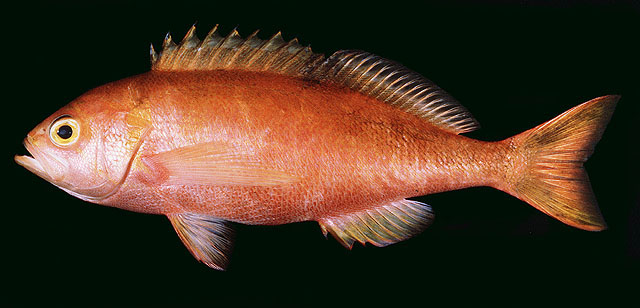| Serranidae (Sea basses: groupers and fairy basslets), subfamily: Anthiinae |
| 55 cm FL (male/unsexed) |
|
reef-associated; depth range 0 - 400 m |
| Eastern Indian Ocean to South Pacific: Eastern Indian Ocean: off Rottnest Island, southwestern Australia (Ref. 7300). Southwest Pacific: Australia, New Zealand, Kermadec Is. Southeast Pacific: Easter I., Nazca Ridge (Ref. 40817), Desventuradas Is., Juan Fernández Is. ( (Ref. 89357). |
|
Dorsal spines (total): 10-10; Dorsal soft rays (total): 19-21; Anal spines: 3-3; Anal soft rays: 8-8; Vertebrae: 26-26. Monochromatic orange-red or with black spots on the dorsal fin (Ref. 43805). Congruent rays of the dorsal fin and a caudal fin with a deep median notch in both sexes (Ref. 43805). Preopercle serrate, but without antrorse spines (Ref. 40817). |
| Occurs inshore near reefs (Ref. 7300). Benthopelagic and benthic (Ref. 58302). Feeds on plankton and small nekton. Occasionally caught on small hooks when fishing in midwater without sinker and make excellent eating (Ref. 30464). Its abundant gillrakers and stomach contents characterize it as an opportunistic pelagic polyphagic-zooplanktivorous predator (Rojas et al. 1998a, c) (Ref. 89357). |
|
(Ref. 96402)
|
| harmless |
|
Source and more info: www.fishbase.org. For personal, classroom, and other internal use only. Not for publication.
Page created by Jen, 05.08.02,
php script by kbanasihan 06/09/2010 ,
last modified by
dsantos, 20/08/10

